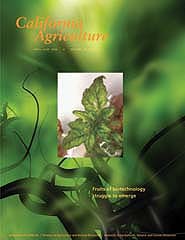All Issues

Fruits of biotechnology struggle to emerge
Cover:
To learn more about citrus floral development genes, UC Riverside scientists are inserting them into tomato plants (inset), whcih express them rapidly. The goal is to improve citrus breeding by producing early-flowering citrus seedings, which normally do not flower for 5 to 13 years.Photo by Martha Orozco-Cardenas.
April-June 2004
Volume 58, Number 2
Volume 58, Number 2





